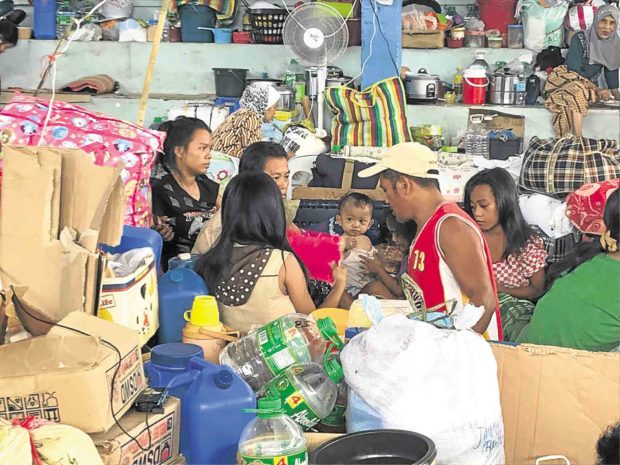
Families who fled Marawi City share every available space in an evacuation center in Iligan City as fighting in their hometown continues. (Photo by ALLAN NAWAL / Inquirer Mindanao)
ILIGAN CITY — Marawi evacuees rejoiced on learning that the fighting in their city might be ending soon. But then their hope of leaving evacuation centers in the next few days was dashed by a projection made by a city official that relocation sites would not be ready for occupancy until next year.
“When I saw on TV government officials announcing that the fighting will be over in 10 days, it gave me hope,” 48-year old Fatima Lumabao said.
Lumabao said the end of fighting means that she would be able to leave the evacuation camp and probably to a more decent place, if not her home in Marawi City.
Omaya Bungaros, a 37-year-old mother of eight, said she was also happy to hear that the crisis was ending. But she felt frustrated when told that they would not be able to move into the relocation site in Barangay Sagonsongan in Marawi City yet.
“We can’t do anything about that but to follow what they say,” Bungaros said. “We would have preferred our home but even moving into a relocation area is not also possible.”
On Thursday, Mohammad Mustafa, the chief building permit officer of the City Engineering Office, said even if the fighting ended soon, displaced Marawi residents would still have to spend more time in evacuation camps because not a single unit at the temporary relocation area in Barangay Sagonsongan had been completed.
In fact, ground works for the initial target of 7,500 temporary shelters started only on Sept. 8.
Mustafa said the first 1,100 units would be completed only before the end of the year.
“We look forward to the completion of the 1,100 units temporary shelters, which we projected could be ready for occupation by January 2018,” he told the Inquirer.
But he said that more units would be constructed on the 11-hectare land that the city government borrowed from various families in Barangay Sagonsongan.
Zia Alonto Adiong, the spokesperson of the Lanao del Sur crisis management committee, said they were concerned about any delay in the relocation of displaced persons but they can only hope it would be fast tracked.
“If there are issues that have already been settled between the government and the private owners of these lots, then I don’t see any reason why it would delay or why the construction would take time,” he said.
But Adiong said they understood that the construction of the temporary shelters depended on actual budget available.
The government had pledged a total of P20 billion for the rehabilitation of the city – including the building of the shelters.
Adiong said part of the budget was already available but it was not clear how much it was.
“But if the city engineers office would project such date, then I guess their judgment depended on actual assessment on the ground and the availability of equipment,” he added.
Mustafa said the goal was to build temporary houses for all 50,000 families displaced by the fighting, which started on May 23, while the government rebuilds the city.
He said under the plan approved by the National Housing Authority (NHA), each unit will house three families.
The temporary shelters, which a Korean company would be building, will be made of steel structures and will be fitted with potable water facilities, toilets and electricity.
The construction of semi-permanent shelters had been decided upon because Lanao del Sur officials said moving the evacuees from neighboring towns in Lanao del Sur, Lanao del Norte and Iligan City into tents against would make them further lose their pride.
Marawi City Mayor Majul Gandamra earlier said providing the evacuees with semi-permanent structures would not only give them a more decent shelter but will provide them a sense of belongingness as well.
“It will also make them comfortable because it will be a house, not just a tent that would always remind them they are evacuees,” Gandamra said.
The military-led Task Force Bangon Marawi, which was tasked with rebuilding the city, later agreed to the construction of semi-permanent structures in Barangay Sagonsongan.
Under the approved plan, each unit will have a total floor area of 26 square meters, Abdulracman Paunte, resident engineer of the DPWH in Northern Mindanao, said.
Paunte said each unit will be constructed for about eight days.
The Sangonsongan site, he said, was divided into five areas.
“Each of the five areas would have communal kitchen, comfort rooms and washing areas. The electricity lines and water system have already being installed and worked on by the Lanao Del Sur Electric Company and the Local Water Utilities Administration,” Paunte added.
Displaced residents the Inquirer had spoken to said they would have wanted to return to their places of origin as soon as the fighting had ended.
/atm